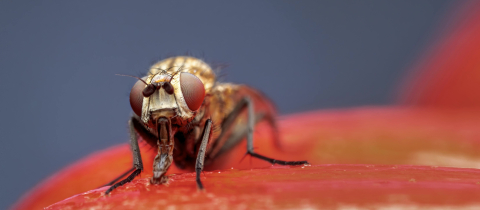Jamie Oliver doesn’t like “pink slime.” He doesn’t want any of it in his hamburger. In fact, the famed British chef was so disgusted that McDonald’s in the U.S. was using this “beef filler” that he orchestrated a campaign to get rid of it. So what is “pink slime,” as Jamie calls it, and what horrors does it hold?
Once a cow has been butchered and disassembled into the various cuts, some fatty trimmings always remain. Traditionally these have been used for pet food, but in 1991, Beef Products Inc., an American company developed a process to convert the trimmings into what it calls “Boneless Lean Beef.” The fatty portions are separated by spinning in a sophisticated centrifuge, leaving behind the muscle tissue which is then ground into a slurry that is roughly 94% lean beef. This “pink slime” is then frozen into chips or blocks, ready to be incorporated into hamburger or into processed luncheon meats.
Because meat trimmings are particularly susceptible to bacterial contamination, the company introduced a novel method to control the risk. Salmonella and E. coli bacteria, having evolved in an acidic environment, cannot survive under basic, or alkaline, conditions. Ammonia gas can introduce such conditions as it dissolves in water to form ammonium hydroxide, a base. An equilibrium is then established between the dissolved ammonia and the ammonium hydroxide, with very little ammonium hydroxide actually being present at any given time. But when it is used up, as in the reaction to destroy bacteria, it is replenished as more of the dissolved ammonia reacts with water.
Ammonia gas is used to treat the beef slurry as it passes through specially designed stainless steel pipes. Some of the ammonia dissolves in the meat’s moisture and maintains the alkaline conditions needed to control bacteria. Neither the dissolved ammonia, nor the ammonium hydroxide it forms presents a health concern. Ammonia is a product of protein metabolism and therefore routinely forms in the human body. It ends up being converted into urea which is then excreted in the urine.
Since alkaline solutions are very effective at breaking down greasy materials, dissolved ammonia is widely used in cleaning agents. Many window cleaning products feature ammonia as their basic ingredient. And when Jamie Oliver made his version of “pink slime” on TV, cleaning agents were prominently featured. In a cleverly crafted “made for TV” piece Jamie opened up a padlocked cabinet, obviously intended to emphasize the danger, and removed a bottle of ammonia that prominently features the skull and crossbones. I’ve never seen such a bottle. He then proceeded to place some meat trimmings in a washing machine that played the role of a centrifuge, and dumped in the ammonia cleaner liberally while admitting he has no idea how much to use. The impression given was that the meat is washed in an ammonia solution which is not at all the case. Jamie’s ugly mash solicited plenty of yucks and eeews from the onlookers along with snide comments about the food industry.
Let’s get real here. Whether or not ammonia is found in cleaning agents has nothing to do with whether it is safe or effective as an antibacterial agent in meat. We don’t worry about salt in our food because it is a substance that is also spread on streets to melt ice. We worry about it because studies have shown that at some dose it can cause problems for some people. Ammonia in meat production has been well studied and it is known that the amount added to “boneless lean beef” does not leave a residue to be concerned about. There is, however, some concern that the amounts used may not offer as much protection against bacteria as claimed. And if more is used, the meat develops an off-taste.
Revulsion of hamburger because an “industrial cleaning agent” is used in processing is not warranted. Neither should the fact that meat trimmings, instead of being used for dog food, are centrifuged into a slurry that ends up in some burgers provoke disgust. When the issue of “pink slime” arises, the appropriate question is whether hamburger made with it differs significantly in terms of nutrition and safety from hamburger made without it.
Perhaps surprisingly, this is not a difficult question to answer. McDonald’s in the US has used “pink slime,” McDonald’s in Canada has not, and the nutritional profile of the company’s products is readily available. The fat and protein content in the US and Canadian burgers is the same. So it seems the use of the highly processed mash doesn’t make a difference. And why should it? The processing actually removes fat from the trimmings. What is then added to the burger is no more fatty than the rest of the meat that is used.
Jamie Oliver professes not to be against eating hamburgers, he says he just wants to know where the ingredients come from. And “pink slime,” he says, is not fit for human consumption. Well, how does one determine if a food is fit or not? By its microbiological safety and its chemical composition, not by its origin! That’s more a matter of social and cultural views. Most North Americans don’t find haggis or snake stew very appetizing but don’t mind gnawing on the ribs of a cow.
Oliver’s crusade for better nutrition is admirable. But imploring people to revolt against the use of ammonia treated beef slurry is a misguided attempt to improve eating habits through scare tactics. Without a doubt, though, such tactics can achieve results. McDonald’s has stopped using pink slime, although the company says the decision had nothing to do with Jamie Oliver’s crusade. Right. Is hamburger made without pink slime in any way healthier? No. Hamburger is a fatty, salty food that should be consumed in limited amounts whether it is made with pink slime or not.
Actually, these days with a push to reuse and recycle, one could argue that methods to convert unusable fatty meat remnants into usable lean beef should be pursued instead of being reviled. Basically, more meat is produced with less feed. Given that there’s no safety or nutritional issue, why is that a problem? Jamie claims that such processing shows “no respect for food or for people.” Why is a more efficient use of butchered animal disrespectful? In any case, killing animals in order to eat them isn’t exactly respectful in the first place, is it?







